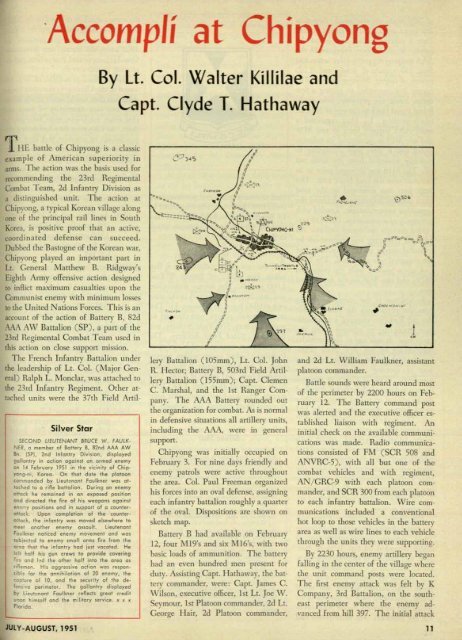July-August - Air Defense Artillery
July-August - Air Defense Artillery
July-August - Air Defense Artillery
You also want an ePaper? Increase the reach of your titles
YUMPU automatically turns print PDFs into web optimized ePapers that Google loves.
"Accompli at Chipyong<br />
iI-IE battle of Chipyong is a classic<br />
example of American superiority in<br />
arms. The action was the basis used for<br />
recommending the 23rd Regimental<br />
C,ombat Team, 2d Infantry Division as<br />
a distinguished unit. The action at<br />
Chipyong, a typical Korean village along<br />
one of the principal rail lines in South<br />
Korea, is positive proof that an active,<br />
coordinated defense can succeed.<br />
Dubbed the Bastogne of the Korean war,<br />
Chipyong played an important part in<br />
Lt. General Matthew B. Ridgway's<br />
Eighth Army offensive action designed<br />
to inflict maximum casualties upon the<br />
Communist enemy with minimum losses<br />
to the United Nations Forces. This is an<br />
account of the action of Battery B, 82d<br />
AAA AW Battalion (SP), a part of the<br />
23rd Regimental Combat Team used in<br />
this action on close support mission.<br />
The French Infantry Battalion under<br />
the leadership of Lt. Co!. (i\lajor General)<br />
Ralph L. Monclar, was attached to<br />
the 23rd Infantry Regiment. Other attached<br />
units were the 37th Field Artil-<br />
Silver Star<br />
SECOND LIEUTENANT BRUCE W. FAULK.<br />
NER, a member of Battery B. B2nd AAA AW<br />
Bn. IS?), 2nd Infantry Division, displayed<br />
gallantry in action against an armed enemy<br />
on 14 February 1951 in the vicinity of Chipyang-ni,<br />
Korea. On that dole the platoon<br />
commanded by Lieutenant Faulkner was attached<br />
to a rifle battalion. During on enemy<br />
attock he remained in an exposed position<br />
I and directed the fire of his weapons against<br />
encl":"Y positions and in support of a counter-<br />
attack. Upon completion of the counterattack,<br />
the infantry was moved elsewhere to<br />
meet another enemy assault. Lieutenant<br />
Faulkner noticed enemy movement and was<br />
subjectod to enemy small arms fire from the<br />
0"0 that the infantry hod just vacated. He<br />
left half his gun crews to provide covering<br />
r" and bd the other half into the area as<br />
riflemen. His aggressive cction was respon.<br />
sib!, for the annihilation of 20 enemy, the<br />
capture of 10, and the security of the de.<br />
fcns:ve perimeter. The gallantry displayed<br />
by Lieutonant Faulkner reflects great credit<br />
uoon himself and the military service. x x x<br />
Florida.<br />
JULY-AUGUST, 1951<br />
By Lt. Col. Walter Killilae and<br />
Capt. Clyde T. Hathaway<br />
lery Battalion (l05mm), Lt. Co!. John<br />
R. Hector; Battery B, 503rd Field <strong>Artillery</strong><br />
Battalion (155mm); Capt, Clemen<br />
C. i\larshal, and the 1st Ranger Company.<br />
The AAA Battery rounded out<br />
the organization for combat. As is normal<br />
in defensive situations all artillery units,<br />
including the AAA, were in general<br />
support.<br />
Chipyong was initially occupied on<br />
February 3. For nine days friendly and<br />
enemy patrols were active throughout<br />
the area. Co!. Paul Freeman organized<br />
his forces into an oval defense, assigning<br />
each infantry battalion roughly a quarter<br />
of the ova!. Dispositions are shown on<br />
sketch map.<br />
Battery B had available on February<br />
12, four 1'I19's and six MI6's, with two<br />
basic loads of ammunition. The battery<br />
had an e\'en hundred men present for<br />
duty. Assisting Capt. Hathaway, the battery<br />
commander, were: Capt. James C.<br />
Wilson, executive officer, 1st Lt. Joe \\T.<br />
Seymour, 1st Platoon commander, 2d Lt.<br />
G~orge Hair, 2d Platoon commander,<br />
and 2d Lt. William Faulkner, assistant<br />
platoon commander.<br />
Battle sounds were heard around most<br />
of the perimeter by 2200 hours on February<br />
12. The Battery command post<br />
was alerted and the executive officer established<br />
liaison with regiment. An<br />
initial check on the available communications<br />
was made. Radio communications<br />
consisted of FM (SCR 508 and<br />
ANVRC-5), with all but one of the<br />
combat vehicles and with regiment,<br />
AN/GRC-9 with each platoon commander,<br />
and SCR 300 from each platoon<br />
to each infantry battalion. \\Tire communications<br />
included a conventional<br />
hot loop to those vehicles in the battery<br />
area as well as wire lines to each vehicle<br />
through the units they were supporting.<br />
By 2230 hours, enemy artillery began<br />
falling in the center of the village where<br />
the unit command posts were located.<br />
The first enemy attack was felt by K<br />
Company, 3rd Battalion, on the southeast<br />
perimeter where the enemy advanced<br />
from hill 397. The initial attack<br />
11
















